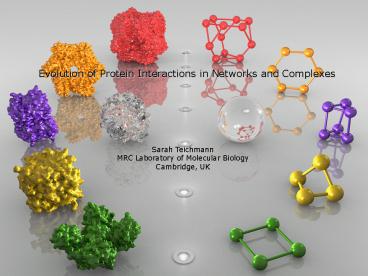Evolution of Protein Interactions in Networks and Complexes - PowerPoint PPT Presentation
1 / 53
Title:
Evolution of Protein Interactions in Networks and Complexes
Description:
rdf:RDF xmlns:rdf='http://www.w3.org/1999/02/22-rdf-syntax-ns#' xmlns:iX='http: ... co P ''a GpSs tFTOdfe n ... – PowerPoint PPT presentation
Number of Views:133
Avg rating:3.0/5.0
Title: Evolution of Protein Interactions in Networks and Complexes
1
Evolution of Protein Interactions in Networks and
Complexes
Sarah Teichmann MRC Laboratory of Molecular
Biology Cambridge, UK
2
The question How do protein interactions
evolve? networks, complexes, 3D
structures sequence and structure
similarity
3
(No Transcript)
4
(No Transcript)
5
Frequency in protein interaction networks?
?
?
Yeast, yeast-large, fly, worm
6
Up to 1/2 interactions in networks1 13
interactions in networks2
1Pereira-Leal, J. Teichmann, S.A. (2005) Genome
Res., 15, 552-559. 2Pereira-Leal, J., Levy,
E.D., Kamp, C. Teichmann, S.A. (2007) Genome
Biol, 8, R51.
7
(No Transcript)
8
(No Transcript)
9
Structures Evolution Assembly in solution
10
Echo and Narcissus
11
How frequent are homo-oligomers?
60 to 70 of proteins form homo-oligomers
12
Selective advantages of homo-oligomers
- Stability of the protein
- Functional advantages
13
3Dcomplex.org - a hierarchical classification of
complexes
Levy, E., Pereira-Leal, J., Chothia, C
Teichmann, S.A. (2006) 3DComplex a structural
classification of protein complexes. PLoS Comp
Biol., 2, e155.
14
A brief reminder of symmetry
15
Evolutionary pathways of complex assembly
16
Symmetries found in a non-redundant set of 2500
complexes
17
Symmetries found in a non-redundant set of 2500
complexes
Even no. of subunits and gt 4 Cyclic
symmetry 2 Dihedral symmetry 22
When there is a choice, dihedral favoured and
10x more frequent than cyclic
18
Evolutionary pathways of complex assembly
19
Structures Evolution Assembly in solution
20
Conservation of Quaternary Structure - Examples
Where do most protein stand on this spectrum?
21
(No Transcript)
22
Model of homomer evolution
Constant probability of dimer-, trimerization etc
independent of size of complex
23
Homology to the largest interface is common
24
An evolutionary relic
25
Predictions based on largest interface
26
A hypothesis evolution predicts assembly pathway?
27
Structures Evolution Assembly in solution
28
Macromolecular mass spectrometry (E.B. Erba
C.V. Robinson)
29
Complexes with characterised assembly pathways -
agreement with predictions
Observed intermediates or perhaps better
sub-complexes
30
Structures 60 to 70 proteins are homomers in
PDB and genomes Evolution Dihedral predominant
over cyclic due to evoln. pathways Assembly in
solution Assembly recapitulates evolution -
large interface intermediates
Interface size and geometry as unifying principle
31
Up to 1/2 interactions in networks 13
interactions in networks
- 2/3 of proteins
- Dihedral complex evolution via dimers or cyclic
w. large interface - Predict evolution and assembly from interface
sizes
32
Acknowledgements
- Jose B. Pereira-Leal,Gulbenkian Insitute, Lisbon
- Emmanuel D. Levy, MRC-LMB
- Cyrus Chothia, MRC-LMB
- Carol Robinson, Dept Chemistry, Cambridge
- Elisabetta Boeri Erba, Dept Chemistry, Cambridge
33
- 60 to 70 proteins are homomers in PDB and
genomes - Dihedral predominant over cyclic due to
evolutionary pathway - Assembly recapitulates evolution - large
interface intermediates
34
- Duplication of interactions forms up to half of
all interactions - Pereira-Leal, J. Teichmann, S.A. (2005) Novel
specificities emerge by step-wise duplication of
functional modules. Genome Res., 15, 552-559.
Pereira-Leal, J., Levy, E.D., Kamp, C.
Teichmann, S.A. (2007) Genome Biol, 8, R51.
35
(No Transcript)
36
(No Transcript)
37
Frequency in protein interaction networks?
P
a
r
alogou
s
Dimers
?
yeast (1 011 interactions) yeast-large (15 393)
fly (2 877) worm (2 422)
Pereira-Leal, J., Levy, E.D., Kamp, C.
Teichmann, S.A. (2007) Genome Biol, 8, R51.
38
Model of homomer evolution
Constant probability of dimer-, trimerization etc
independent of size of complex
39
(No Transcript)
40
Obser
v
e
d
0.12
s
P
a
r
alogou
s
Expected
action
Dimers
0.1
r
0.08
action of inte
0.06
0.04
r
f
0.02
0
Y
eas
t
Y
eas
t
-larg
e
Fly
W
or
m
Up to 13 pairwise interactions are between
homologues
41
Gene duplication allows asymmetric binding
others CCT proteasome exosome,
spliceosome Photosystem I
Pereira-Leal, J., Levy, E.D., Kamp, C.
Teichmann, S.A. (2007) Genome Biol, 8, R51.
42
Conservation of Quaternary Structure
Down to 30 sequence identity, 70 of protein
pairs have their quaternary structure conserved
43
(No Transcript)
44
Frequency of homology between symmetry types
45
(No Transcript)
46
A brief reminder about symmetry
47
(No Transcript)
48
Evolutionary pathways of complex assembly
49
Subunit arrangement
- Homo-oligomers are made of repetitions of the
same protein and can form
Open complexes (may form filaments)
Closed complexes (may not form filaments)
This type of complex can be deleterious for an
organism (Sickle cell anemia, Huntingdon, Parkinso
n, Alzheimer)
Majority of complexes
50
Representing complexes in a simple form that
summarizes key features, and allows comparison
Process inter-sub-units contacts Detect
identical chains Detect structural homologies
(Using the SCOP classification)
Nodes are polypeptide chains Edges are
interfaces between chains Same color - same
gene Same shape - homologous gene
51
Convert all atomic structures into
graphs,compare and group similar graphs
20875 structures (including monomers)
52
3Dcomplex.org - the hierarchical classification
Levy al, Plos Comp. Bio. 2006
53
An evolutionary relic































